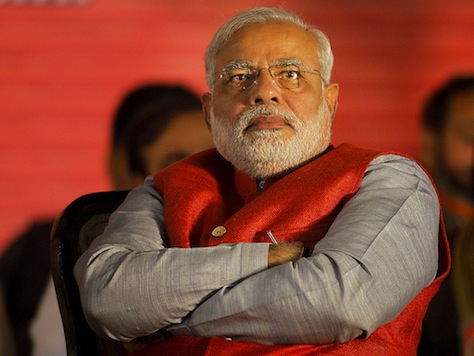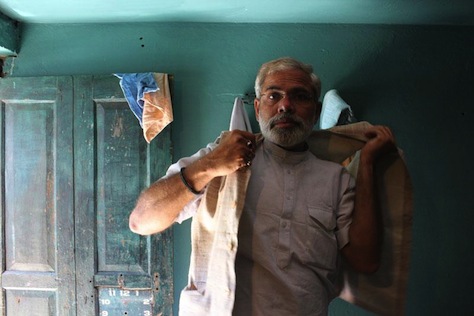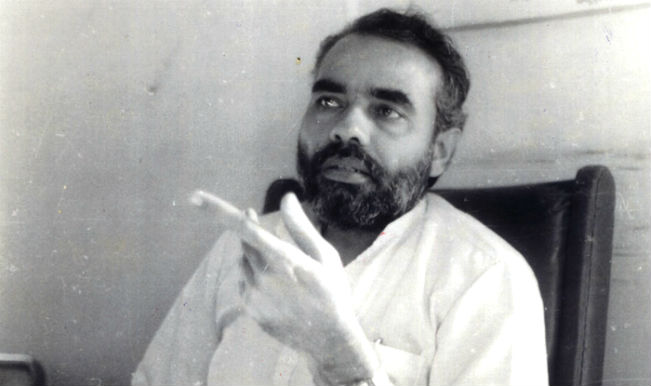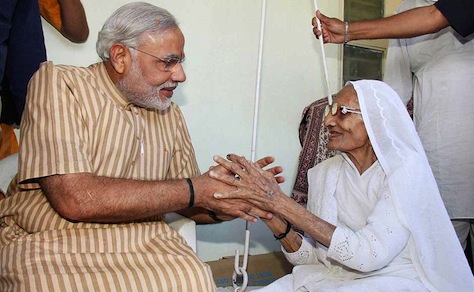It’s not hard to understand why Gujarat chief minister Narendra Modi is leading his Bharatiya Janata Party (the BJP, भारतीय जनता पार्टी) and its allies to a victory that will be the most resounding in Indian history since 1984.![]()
The truth has been there all along, as Narendra Modi became more than just a potential prime minister. Somewhere along the course of the election campaign and the nine phases of voting that began way back on April 7, Modi became a phenomenon.
* * * * *
RELATED: In-Depth: India’s elections
* * * * *
Even before he leapt to the national stage, Modi perfected the art of campaigning by hologram, whereby a life-size avatar of Modi could address election rallies in multiple cities simultaneously:
His colorful kurtas — traditional body-length garments for men that Modi often wears with short sleeves — have become a downright fashion statement and have already attracted international attention. Here he is in a great photo from Sonia Paul of The Caravan:
Modi himself has admitted to a bit of cockiness about his fashion:
[Modi] confesses he likes to dress up well, is “god-gifted” in the way of mixing and matching colours and is happy at compliments on his dressing sense…. “Yes, I like to dress up well and stay clean. God has gifted me the sense of mixing and matching colors. So I manage everything on my own. Since I’m god-gifted, I fit well in everything. I have no fashion designer but I’m happy to hear that I dress well.”
Implausibly, as he brags about his 56-inch chest (critics joked it was more like a 56-inch belly), he’s also become something of a sex symbol among a certain segment of India’s population.
But when, as now seems inevitable, he becomes India’s next prime minister, the entire world will turn its attention to one of the oddest — and compelling — characters in international politics today.
So who is the personal Narendra Modi? And what have we learned about him on the campaign trail?
He’s a vegetarian (not terribly uncommon in India). He doesn’t smoke and he doesn’t drink (also not terribly uncommon in India). He writes poetry in his native Gujarati language.
By all accounts, he’s a workaholic — and he’s a micro-manager, having held the finance ministry in Gujarat, along with other portfolios in his early days running the state.
Though he’s presented himself as a life-long bachelor, he was once married — at age 18 to a woman named Jashodaben Chimanlal. Until past month, he oddly even refused to acknowledge his childhood marriage at age 18, though his brother explained that the marriage was rooted in tradition:
“Narendra was married to Jashodaben at a very young age by our parents, but it was only a formal ritual as Narendra left the house in those days itself,” Modi’s older brother Somabhai said. Somabhai said that Modi, after leaving the house, has not kept any contact with the family, as “service to the nation was his only religion”.
“His marriage was just a formality as he left the house soon after his marriage. Even Jashodaben has been living at her father’s home and spending her life working in the education sector,” Somabhai said. “The incident (Modi’s marriage) which had occurred 45-50 years ago is to be seen in the background of a poor and traditionally orthodox family,” he said.
His wife, who is now a retired 62-year-old schoolteacher, however, wishes him the best and has been praying for him to become prime minister.
Modi, for his part, seems to have went off to travel in the Himalayas for two years, then came back and joined the Rashtriya Swayamsevak Sangh (RSS) in 1971, which requires a vow of chastity.
Modi is the son of a modest family, and he once sold tea with his father at railway and bus stations. When he returned from his travels, he sold tea from a stand in Ahmedabad with his brother. Whereas an American politician might brag about his humble upbringing rooted squarely in strong Christian morals, Modi can point to his background as a humble chaiwallah that’s grounded his own values.
Today, arguably, the closest woman in his life is his mother Hiraben, who is still alive at age 95.
The most significant scandal, after the communal riots that took place 12 years ago, is something called ‘Snoopgate,’ in which Modi had his former home minister, Amit Shah, monitor the movements of a young woman and tracked her telephone conversations. While Modi’s associates concede that his government placed her under surveillance, they claim it was done for her own security. No one really knows the entire story.
Modi is a member of the OBC, the ‘Other Backward Classes,’ a caste classification. While Modi himself isn’t a dalit (what is still more commonly known in the West as ‘untouchable,’), and his classification as OBC has been subject to some scrutiny, he will become the lowest-caste prime minister in Indian history.
When, just over a week ago, he picked a fight with the entire Gandhi family, he played the caste card:
[Rahul Gandhi’s sister, Priyanka] Vadra accused Modi of practicing ‘neech rajniti‘ — or low-level politics — and Modi slammed back that it’s not a fault that he was born into a ‘neech jaati‘ — or lower caste.




